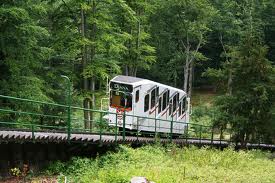The Kiev funicular
 One of the symbols of Kiev is a funicular railway - a rather exotic and rare form of transport and at the same time a monument of architecture of XIX century Kiev.
One of the symbols of Kiev is a funicular railway - a rather exotic and rare form of transport and at the same time a monument of architecture of XIX century Kiev.Rent an apartment in Kiev in the heart can not get up from his chair.
The word "funicular" derives from the Latin funiculus - a rope, and refers to MAST-vehicle traction on the cable, designed to move passengers over short distances at considerable angles of ascent.
It has long been a steep rise from Podol created difficulties for the people of Kiev. Winding paths and even later the wooden stairs leading to St. Michael's Square, numbering exactly 500 steps and 36 landings, special facilities are not provided. Only existed at the end of the nineteenth century, the mechanical means of communication between the city and the Upper Podil was a tram, which took place on the slope of Vladimir. And Andrew's descent was even steeper, so that the building where the tram path, from an engineering point of view, we could not go at all (although such proposals were put forward by some MPs and city council).
But the development of so called for improvements to the site traffic, and that was the beginning of designing the cable car, rather expensive to operate compared with the tram, but the only possible and reliable vehicle for steep slopes The idea of ??building in Kiev funicular put forward as early as 1883, Arthur Adolfovich Abragamson (1854 - 1924) - Russian statesman, director of the Moscow-Kazan Railway, a railway engineer, the author of several works on the railway construction, urban management and technical vocational education. He later became a project manager and the mastermind behind the construction of the cable car, when in 1902, City Council adopted its proposal to organize transport to and from Podolia and the Upper Town, and requested the engineer Nicholas Pyatnitskoe develop travel design and architect Alexander Baryshnikov - to design the station halls. Design work carried out during 1902 - 1904's., And construction was completed in May 1905. Viaduct being constructed on the best technology for that time - using reinforced concrete. General contractor of the Company acted Bahn - the former Belgian electric company - owner of the Kiev tram company. The construction of the funicular cost the city treasury in a rather impressive amount - 172,000 rubles.
The solemn opening ceremony of the consecration of St Michael and mechanical lift (as he was officially called until 1928) was held on May 7, 1905. This date is the official beginning of the history of this unusual transport in Kiev. In those days the funicular carriages had a seating capacity of about 70 people each. The lower station is located on the street Borichev current, and the top - by St. Michael's Square, near the entrance to St. Michael's Cathedral. The length of the track was two hundred meters. Powered cars in motion a huge electric motor of 70 kW, installed on top of the station.
Time passed ... survived the funicular revolution, civil war and devastation, and his carriages continued to regularly carry passengers. But there came a fatal cable car in 1928, when the deterioration exceeds allowable cable pulling. And while it is replacing the top fell off the wagon clamping jaw and flew down. Having developed a tremendous speed, he ran with tremendous force to the bottom. Both cars were broken into pieces. Fortunately, none was hurt. But this case gave rise to the reconstruction of the entire structure. New cars produced at the Kiev factory of electric, improved design of brake band and, more importantly, the way lengthened by 38 meters, erecting the lower station of the Revolution on the street - so at that time called the present street Sagaidachnogo. And at the end of the funicular repair work continued with even greater rates of transport of Kiev and guests.
And 13 years later - in the early 70s of last century the Kyiv Regional Inspectorate has strengthened control over the operation of the cable car and demanded to improve the quality of service and security. Inspectorate were also brought claims for insufficient length of the upper station and the lack of traction on the brakes - "wheel", posted at the top station, which is carried out and raising and lowering wagons.
After the visit of the Regional Institute of Inspection "Kyivproject" began to develop options for addressing the funicular. By 1976, the Institute has developed three projects - the reconstruction of the existing cable car, the replacement of the cable car lift to the escalator, and the construction of high-speed elevators. Preference is known to have given all the same cable car.
Reconstruction was carried out in 1984 - 1986 years. (Architects J. J. Vig, V. Yezhov, A. Chupak, VM Sharapov, engineers, VA Reznikov, N. Naik), during which 5 meters was extended upper station completely rebuilt the bottom, replaced by traction, served faithfully for nearly 80 years. And after the third reconstruction of the cable car cabins are still pleasing to the eye of Kiev and tourists.
At present, 2008 was planned for the fourth in a row reconstruction in which supposed to replace the rolling stock and to repair stations.
The Kiev funicular annually transports more than 4 million passengers, while load and vozrostala to 7.7 million passengers.
This kind of public transportation has been and remains, as before, demanded a vehicle, attracting the attention of both Kiev and guests.
Andrew Sokhan



